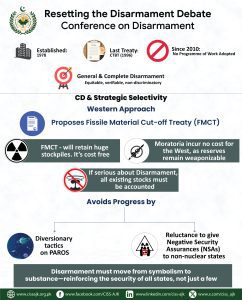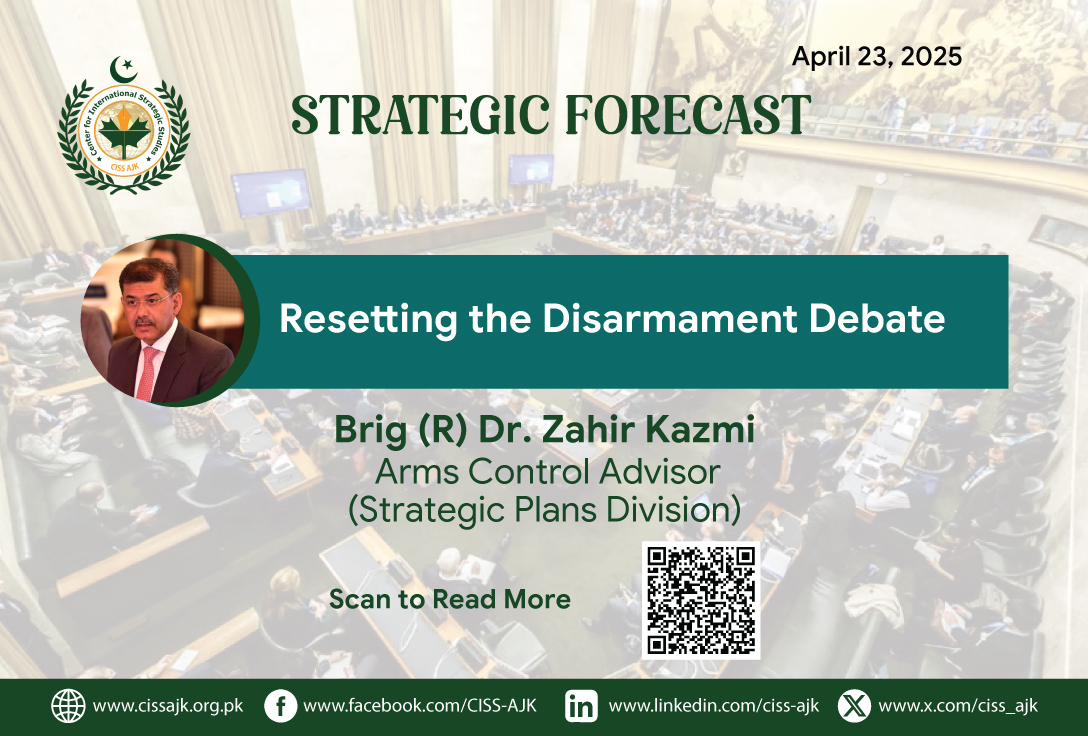 The Conference on Disarmament (CD), long viewed as the world’s principal negotiating forum for arms control and disarmament, is now better described as a diplomatic treadmill—where delegations run endlessly, burn energy, and yet fail to move forward. Its last treaty, the Comprehensive Test Ban Treaty, was concluded nearly three decades ago. Since 2010, it has not adopted a Programme of Work.
The Conference on Disarmament (CD), long viewed as the world’s principal negotiating forum for arms control and disarmament, is now better described as a diplomatic treadmill—where delegations run endlessly, burn energy, and yet fail to move forward. Its last treaty, the Comprehensive Test Ban Treaty, was concluded nearly three decades ago. Since 2010, it has not adopted a Programme of Work.
While structured discussions have resumed in recent years through subsidiary bodies, reaffirmed again in 2025, dialogue without convergence has only highlighted the persistence of deeper structural divisions. What we are witnessing is not merely a procedural delay but a more entrenched crisis of disarmament equity—where restraint is negotiable, but dominance is not.
The CD was created to uphold the vision of the First Special Session on Disarmament in 1978—general and complete disarmament under strict international control, pursued through equitable, verifiable, and non-discriminatory means. That vision today is buried under the weight of bloc politics and strategic selectivity.
Nowhere is this clearer than in the treatment of the so-called Fissile Material Cut-off Treaty (FMCT), long championed by Western powers as the “next logical step.” Yet these same powers sidestep legally binding instruments on outer space and Negative Security Assurances (NSAs) to non-nuclear weapon states. This strategic selectivity exposes the central paradox of disarmament diplomacy: those who demand progress often perpetuate the imbalances that preclude it.
 Pakistan remains firmly committed to global disarmament—but not on terms that codify inequality. Disarmament must be universal, verifiable, and non-discriminatory. These are not semantic nuances; they are essential to any sustainable peace.
Pakistan remains firmly committed to global disarmament—but not on terms that codify inequality. Disarmament must be universal, verifiable, and non-discriminatory. These are not semantic nuances; they are essential to any sustainable peace.
Consider the case of India. Its unsafeguarded plutonium stockpile alone exceeds 3,000 kilograms, according to conservative Western estimates. None of it is under IAEA safeguards. This material can be converted into at least 500 nuclear bombs—placing India third globally in potential warhead count, after the U.S. and Russia.
An FMCT that exempts such stockpiles would institutionalize asymmetry, not reduce it. Those who declared moratoria after accumulating large stockpiles incur no cost. They retain the ability to weaponize those reserves while pressing others to accept production limits. This is not progress. It is strategic hedging under a disarmament label.
This is not obstructionism. Pakistan’s rejection of a flawed FMCT is principled. A treaty that ignores past stocks would entrench India’s fissile advantage in South Asia and permanently shift the deterrence balance. Such a treaty would not be equitable—it would be destabilising.
Pakistan maintains Full Spectrum Deterrence within a Credible Minimum framework. Islamabad does not pursue ICBMs. Its arsenal is designed to deter existential threats—not to project power. Pakistan’s call for reciprocity is not transactional; it means legal obligations must apply to all—including verifiable treatment of existing stockpiles, not just future production.
Of all CD agenda items, NSAs should be the least controversial. These do not require disarmament—only a political pledge not to use nuclear weapons against non-nuclear weapon states. That even this lowest-hanging fruit remains unpicked speaks volumes about the asymmetry in the disarmament regime.
The same selective logic applies in outer space. Pakistan has consistently advocated for the Prevention of an Arms Race in Outer Space (PAROS) not as rhetoric, but as a strategic imperative. It is party to all five UN space treaties, including the Moon Agreement—a distinction not shared by many, including India.
India’s 2019 anti-satellite (ASAT) weapon test generated over 400 pieces of orbital debris in under ten minutes—more than several countries have across decades of peaceful space activity. This debris endangered civilian and commercial satellites. India’s satellite-targeting capabilities also pose risks to the space assets of its allies and strategic partners. Despite claiming strategic autonomy, India offers no assurance that it would refrain from targeting the space infrastructure of current collaborators in a future contingency.
Meanwhile, India’s joint Synthetic Aperture Radar Mission (NISAR) with NASA is framed as peaceful cooperation but provides dual-use capabilities that strengthen strategic surveillance and military applications. Coupled with the U.S. relaxation of Missile Technology Control Regime guidelines, these partnerships are fuelling destabilising capabilities that extend beyond Earth’s atmosphere.
Pakistan champions legal equity in space. Others pursue dual-use alignments that erode norms. Western proposals on responsible space behaviour are narrowly confined to non-binding norms—focused on kinetic-energy ASAT weapons tests alone. This allows those who already possess such capabilities to retain them while facing no constraints on non-kinetic or emerging ASAT technologies. It reinforces a divide between “space haves” and “have-nots,” privileging status over stability.
Norms have not stopped ASAT tests. Only legally binding commitments can offer credible restraint. That is why Pakistan supports the China-Russia draft treaty on the Prevention of the Placement of Weapons in Outer Space and continues to co-sponsor the annual UNGA resolution on PAROS. A treaty is not just desirable—it is overdue.
The CD’s relevance is fading not because of a lack of dialogue, but due to the disproportionate focus on a single agenda item—FMCT—while sidelining older and arguably more stabilising proposals like PAROS and NSAs. The 2009 FMCT push failed because it ignored regional realities. History has made that clear.
Today, emerging technologies—AI-enabled weapons, autonomous systems, hypersonics, cyber tools, and counterspace systems—are eroding what little restraint remains. These technologies are not peripheral. They are transforming the strategic environment in which disarmament must now operate. The CD must align its agenda with these contemporary realities and recognise how these threats compound existing asymmetries.
The way forward is not more compartmentalised dialogue. A disarmament framework that tolerates selective acceleration in one domain while stalling others only accelerates global insecurity. The CD must adopt a package approach—giving precedence to nuclear disarmament, PAROS, and NSAs. De-linking these issues will only deepen mistrust and ensure continued deadlock.
Disarmament must move from symbolism to substance. The CD must reject hierarchies of security. For disarmament to be credible, it must reinforce—not undermine—the security of all states, especially those facing structural and doctrinal asymmetries.
The question for the major powers is this: Will you lead by example—halt nuclear modernisation, ratify the CTBT, and engage seriously on PAROS—or remain architects of strategic stagnation?
Pakistan remains ready to engage—constructively, transparently, and responsibly. But never on the basis of selective obligations or strategic exceptionalism.
Disarmament must not be a mechanism of control. It must become an instrument of collective responsibility.
Author
The author is the Arms Control Advisor, SPD. The views expressed are solely his and not necessarily Government’s policy.

